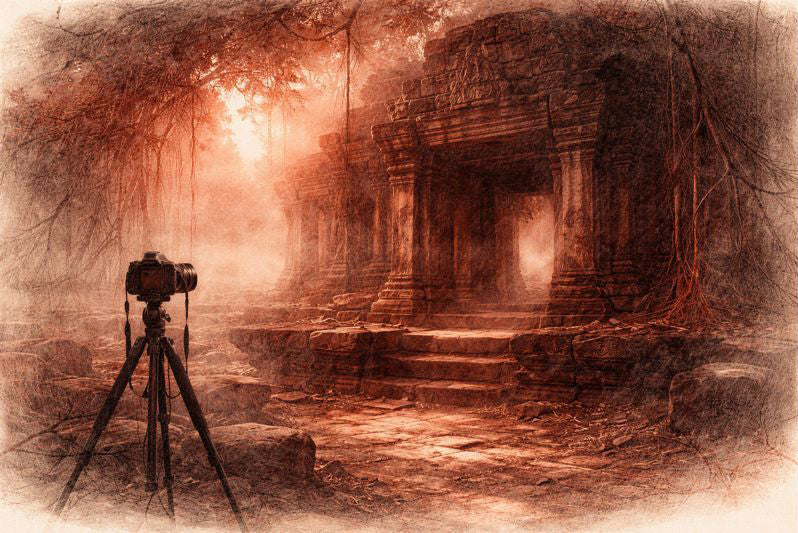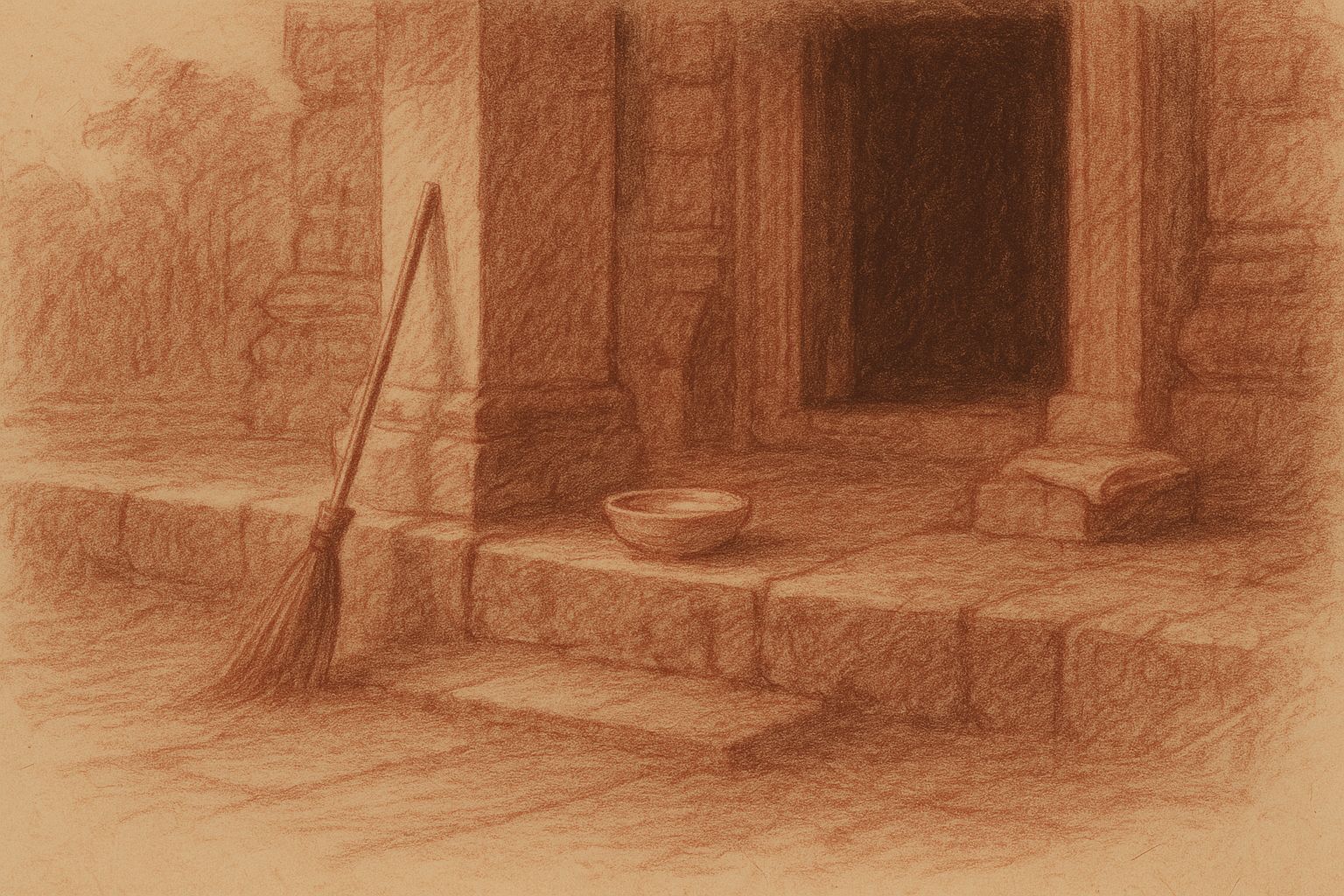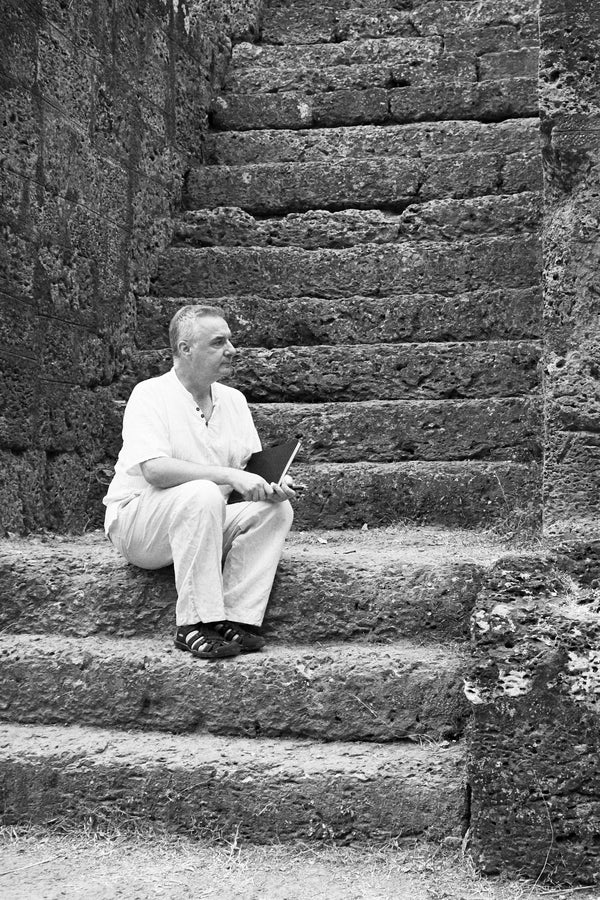Complimentary worldwide shipping on orders over $400 · No import tariffs for most countries
Complimentary worldwide shipping on orders over $400 · No import tariffs for most countries

The Churning of the Ocean of Milk at Angkor Wat Temple, Part II: The Asuras
4 min read
We begin our examination of the spectacular Churning the Ocean of Milk relief panel at Angkor Wat Temple by starting from the left (southern) side, where we see the asuras pulling the great naga Vasuki, who acts as the rope around the churning post.
In Khmer reliefs the asuras are depicted to the south, the devas to the north.

Figure 1. Asura Reserves, Churning of the Ocean of Milk, Angkor Wat Temple, Cambodia
You can see a larger version of this image by clicking here. ⧉
In Figure 1, to the far left of the panel before the lively action, we see the reserve armies of the asuras. We see infantry/cavalry in front of their horses on the lower register, and more infantry in front of horse-drawn chariots and elephants bearing howdahs in the upper pseudo-registers. Mannikka suggested that these represent a crowd of Khmer onlookers who would have gathered at the coronation (Indrabhisheka) of the king, to watch the enactment of the scene of the Churning.
The 92 asuras are led by three gigantic figures, at the front, middle and end. In iconography the asura and rakshasa kings Hiranyakasipu, Kalanemi, Bali, Bana, and Ravana are all depicted with multiple heads and arms and monstrous faces, and it isn't possible to be certain of the identification of these heroic asura leaders. The three that I identify below as Bali, Kalanemi, and Ravana are possibly interchangeable.
The asuras are depicted almost identically to the devas on the right (northern) side of the panel, the main distinguishing feature being the asuras' crested helmets versus the devas' conical crowns. The slow churning rhythm of the asuras and devas, with one of the heroic-sized figures interspersed regularly among their ranks, is a beautiful example of rhythmic composition.

Figure 2. Bali Churning the Ocean of Milk, Angkor Wat Temple, Cambodia
You can see a larger version of this image by clicking here. ⧉
In Figure 2, we see the first asura king on the left, holding Vasuki’s head as the anchor for his team. This is probably Bali, one of the greatest asura kings. The amrita obtained during the Churning enabled his subjects to bring him back to life after his death in a later war with the devas.
Note that the snake Vasuki is depicted twice, one at the bottom of the ocean and the other acting as the rope for the Churning. Coedès suggested that the sculptors wanted to represent the moment before the Churning when Vasuki was resting at the bottom of the ocean before being pulled out by the devas and asuras and used as the churning rope. Whatever the reason, the additional snake at the bottom of the ocean frames the composition beautifully.

Figure 3. Kalanemi Churning the Ocean of Milk, Angkor Wat Temple, Cambodia
You can see a larger version of this image by clicking here. ⧉
Kalanemi is an asura king, enemy of the gods. In the Ramayana he is Ravana’s uncle. In the Puranas he is the son of Varochana, the grandson of Hiranyakasipu. He was killed by Vishnu, but was said to live again in Kamsa and in Kaliya.
Mannikka, on the basis of the type and amount of sunrays the personages receive during the winter and summer solstices, proposed that this asura leader is one of the many forms taken by Vishnu to assist in the Churning, in this case his 'asura form'.
Along the top of the panel is a register teeming with the newly created apsaras in graceful flight.

Figure 4. Ravana Churning the Ocean of Milk, Angkor Wat Temple, Cambodia
You can see a larger version of this image by clicking here. ⧉
As we shall see on the devas' side of the panel, this representation of the Churning is strongly influenced by the Ramayana, with two of the their leading figures possibly meant to be Rama's rakshasa ally Vibhishana, and the other figure of a monkey king likely to be Sugriva. The attendance of Vibhishana and Sugriva at the Churning is not mentioned in the Puranic text, but their inclusion was, presumably, popular at that time in the local version of the Ramayana. For this reason, it may be that one of the multi-headed and multi-armed heroic figures sculpted on the side of the asuras may he Ravana, the demon king of Lanka. A similar Ramayanic influence appears in the relief of the same myth sculpted in the northwestern inner gallery of Bayon Temple.
At the bottom of the panel we see a register depicting marine life, including nagas and reachisey (a sort of dragon with four short legs), being tossed around by the Churning, with those creatures closest to the churning vortex being chopped to pieces.
Next, we will continue with our examination of this relief in The Churning of the Ocean of Milk at Angkor Wat Temple, Part III: Vishnu Presides.
Also in Library

Before the Shutter Falls
3 min read
Before the shutter falls, fear sharpens and doubt measures the cost of waiting. In the quiet hours before dawn, the act of not-yet-beginning becomes a discipline of attention. This essay reflects on patience, restraint, and the quiet mercy that arrives when outcome loosens its hold.

Those Who Keep the Way Open — On the Quiet Guardians of Angkor’s Thresholds
3 min read
Quiet gestures shape the way into Angkor — a swept stone, a refilled bowl, a hand steadying a guardian lion. This essay reflects on the unseen custodians whose daily care keeps the thresholds open, revealing how sacredness endures not through stone alone, but through those who tend its meaning.

Multiplicity and Mercy — The Face Towers of Jayavarman VII
5 min read
A new vision of kingship rises at the Bayon: serene faces turned to every horizon, shaping a world where authority is expressed as care. Moving through the terraces, one enters a field of steady, compassionate presence — a landscape where stone, light, and time teach through quiet attention.
Join My Studio Journal
Receive occasional letters from my studio in Siem Reap—offering a glimpse into my creative process, early access to new fine art prints, field notes from the temples of Angkor, exhibition announcements, and reflections on beauty, impermanence, and the spirit of place.
No noise. No clutter. Just quiet inspiration, delivered gently.
Subscribe and stay connected to the unfolding story.

Join My Studio Journal
Receive occasional letters from my studio in Siem Reap—offering a glimpse into my creative process, early access to new fine art prints, field notes from the temples of Angkor, exhibition announcements, and reflections on beauty, impermanence, and the spirit of place.
No noise. No clutter. Just quiet inspiration, delivered gently.
Subscribe and stay connected to the unfolding story.
